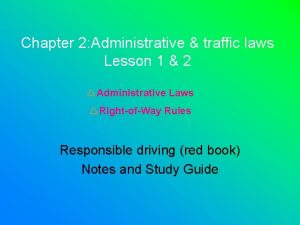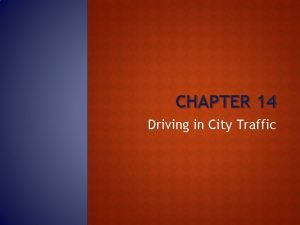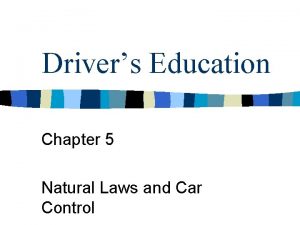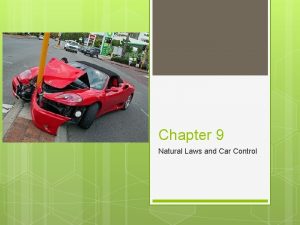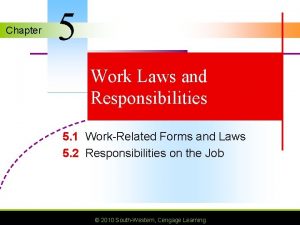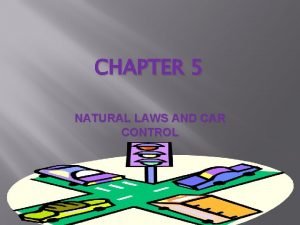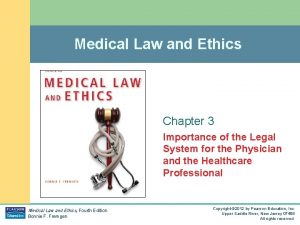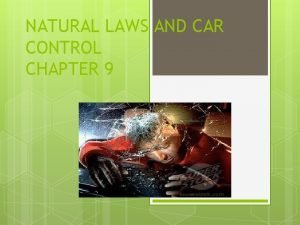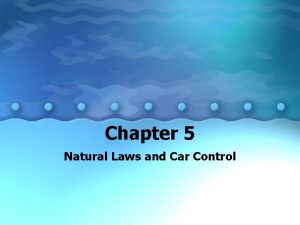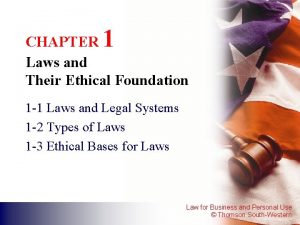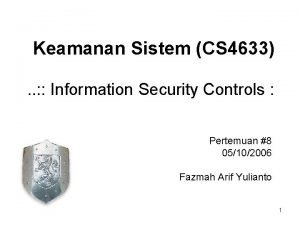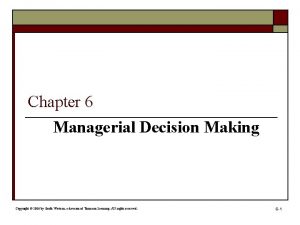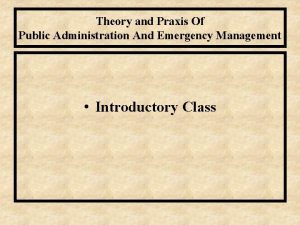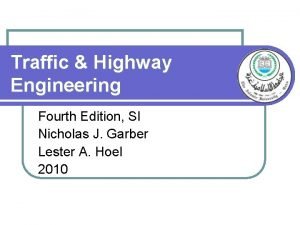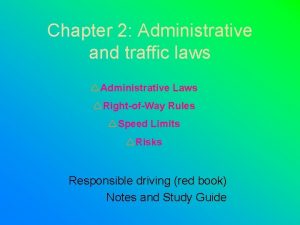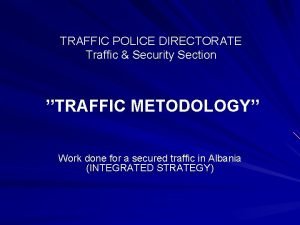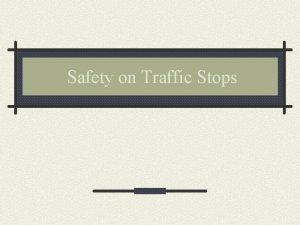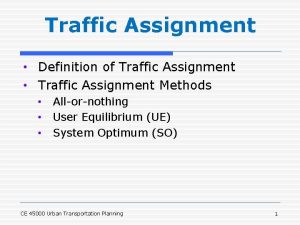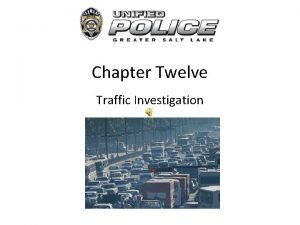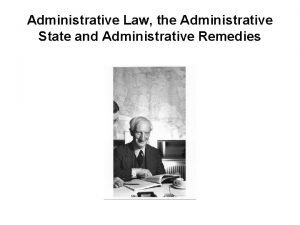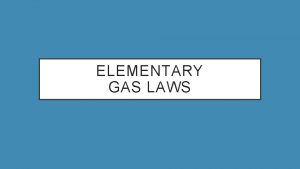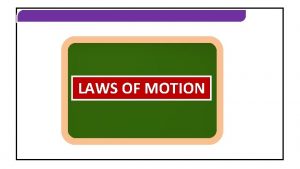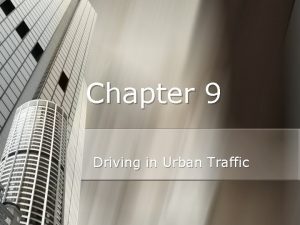Chapter 6 Administrative and Traffic Laws Administrative Laws































- Slides: 31

Chapter 6 Administrative and Traffic Laws

Administrative Laws �Each state has laws that control its highway transportation system. (National Highway Traffic Safety Administration is the national organization) �Administrative Laws – Establish the procedures for issuing and removing people’s driver’s licenses, for registering a vehicle, and for securing a title. Other administrative laws cover the financial responsibilities of vehicle owners and drivers and establish standards for the minimum safety equipment and care of the vehicle.

Getting a Driver’s License �Driving is a privilege, not a right �You must pass a series of tests including: �Vision Test �Knowledge Test �Road Test

Suspensions �States reserve the right to suspend, revoke, and penalize licensed drivers for listed infractions �Suspensions – Temporarily eliminate driving privileges due to a violation. (duration of suspension varies depending on severity of the violation. ) �Licenses are typically suspended for 30 -90 days and always fewer than 365 days.

Revoked License �States reserve the right to revoke a license and strip the powers of operating a motor vehicle. �Revoked license – Take license away (duration depends on the severity of the violation). �When the revoked period has passed the driver must reapply for another license.

Point System �Suspensions and revoked license depend on a point system. Excessive points on your license can lead to surcharges imposed by the state and your insurance company. �Point System – A driver receives points based on a violation which remains on their record. Each traffic violation “costs” a number of points and when accumulated can lead to suspension or revoking. �Examples of point earning infractions are: � DUI: Driving Under the Influence � Collisions � Moving Violations

Certificate of Title �Proves ownership of the car you claim to own. It lists the following: �Name of owner �Make and style of vehicle �VIN # (Vehicle Identification Number) �Engine Number This document must be presented when attempting to sell a car and if buying a car you should always ask to see the title to ensure that they vehicle does belong to the person who claims ownership. Therefore, this document should be kept in a very safe place.

Vehicle Registration �Your registration reveals who is responsible for operating the vehicle. When a car is registered you will receive a registration certificate and license plates. �Your vehicles registration must be reregistered every year or two. �Keep the registration in the vehicle it belongs to and place the correct registration stickers on the license plates as legally required

Insurance �Auto insurance pays some of the bills when you crash and is required in New York. �Insurance offsets the costs of a collision by paying a portion of the damages for your car as well as the other person involved in the crash if you are found liable. �Costs could include death, injury, or property damage.

Right of Way Rules �Right of way rules can help improve traffic flow, minimize confusion, avoid collisions, identify liability, and decrease emotional driving. �These rules are not state mandated and are consistent throughout the United States. �You can avoid a collision by knowing who should go first and who should wait. To do this, you need to know the rules that govern right-of-way. �Right-of-way laws in every state are based on the Uniform Vehicle Code, which are vehicle laws recommended by a national committee and used in part by all states.

Right-of-Way �The right to proceed first. There are situations in which you must always yield the right of way: �Yield the right of way to any emergency vehicle, such as an ambulance, that has hits sirens on and its lights flashing. If you are going in the same direction as the emergency vehicle, move to the far right of the road and STOP. If you are traveling the opposite direction, move to the far right. You do not have to stop in this case but always move to the right. �Yield to people who are blind and carrying a white cane or guide dog regardless of where they are crossing the street. �Yield the right of way to all pedestrians.

4 way stop rules �Who has the right-of-way? �Whoever gets to the intersection first has right-of-way. �If you arrived at the same time, always yield to the vehicle to the right. (that means knowing when you are on the right of someone else as well) �If there is a vehicle coming from the opposite direction, the person going straight has the right of way. �Always yield to pedestrians. �NEVER ASSUME THE OTHER PEOPLE AT THE INTERSECTION ARE GIVING YOU THE RIGHT OF WAY. ALWAYS WAIT TO ASSESS THE SITUATION.

Four way stop

Speed Limits �Speed limits are assigned to all roadways and posted to protect ALL drivers. Traffic engineers study road conditions, traffic patterns, and collision frequency to assess the appropriate speed limit for each road. �Posted speed limits are not regulations demanding that you drive that speed on that road. Speed limits express the maximum speed at which you should travel under the BEST WEATHER AND ROAD CONDITIONS.

Types of Speed Limits �Fixed Speed Limit – a maximum or minimum speed that a vehicle may be driven on a particular roadway. Fixed speed limits DO NOT change. �Advisory Speed Limits – informs drivers to interrupt their current driving speed for a limited time. This is due to roads going up and down hills, over bridges, and around sharp curves. �Day and Night Speed Limits – some states have lower speed limits at night. Night driving is more dangerous due to visibility.

Fixed speed limit

Advisory speed limit


Basic Speed Laws �All states have basic speed laws: Always drive at a speed that is reasonable and proper for existing conditions. Your ability to manage visibility, time, and space also determines what is a safe speed at any given time. �Basic speed laws are determined by various situations: �Road condition �Weather �Traffic �Light

Weather Conditions

Road Conditions

Light

Continued �Drivers can be cited for traveling below or above the posted minimum and maximum speed limits if conditions permit. � 55 mph+ : more than half of all fatal crashes occur on roads with posted limits of 55 miles per hour or more. Driving faster than the posted speed limit is never safe or reasonable. The following facts reveal critical information about speed. �The higher the speed: � The less time the driver has to spot dangerous situations and take action. � The greater the time and distance it takes to change direction or stop a vehicle. � The greater the chance the vehicle will skid or roll over on a turn. � The greater the chances of collision, personal injuries, and property damage.

If You Are Involved in a Collision

Stop at the Scene �The first thing you do if you are involved in a collision is stop immediately �Don’t have to have damage to your own vehicle to be involved � Must stop if you directly or indirectly cause a collision � NEVER leave the scene of an accident unless directed to by law enforcement or emergency personnel �“Hit & Run” � Leaving the scene or failing to stop following a crash � Felony crime �Do not have to stop at the exact spot of the collisions � If your vehicle is still drivable and you are not injured, move your vehicle out of harm’s way staying as close to the crash site as possible �Turn on hazards and locate crash victims

Warning Others �Mark the crash scene with flares, emergency triangles, or other warning devices �Place them from 100 -500 feet behind vehicles involved in the collision �Higher the speed of traffic, farther back they should be placed �If you don’t have any of these �Open the hood of the vehicle �Use a flashlight or bright colored clothing

Giving Aid �Most people who die in collisions might otherwise live if they were to get immediate care from others �Depending on the site of the crash, emergency medical help could take a while �Provide care to the injured only if you feel comfortable doing so �Don’t hesitate if you are the only person available �Good Samaritan Law � Protects those who try to give first aid in emergency situations from being liable for injuries or fatalities that they may cause or assist in causing because of the quality of the first aid administered � In some jurisdictions, doing nothing is a punishable offense

Giving Aid �Most people who die in collisions might otherwise live if they were to get immediate care from others �Depending on the site of the crash, emergency medical help could take a while �Provide care to the injured only if you feel comfortable doing so �Don’t hesitate if you are the only person available �Good Samaritan Law � Protects those who try to give first aid in emergency situations from being liable for injuries or fatalities that they may cause or assist in causing because of the quality of the first aid administered � In some jurisdictions, doing nothing is a punishable offense

Calling for Help �Use your cell phone to call 911 �No cell phone or radio, try to find a pay phone �Be prepared to tell the dispatcher your name, phone number, what happened, number of victims, exact location of crash �Use landmarks, distance markers, cross streets, offramps, or any geographic features to identify where you are �Stay on the line until help arrives or dispatcher says so �If vehicle is undrivable, call towing service

Exchanging Information �Exchange names and addresses with all drivers and passengers, vehicle registrations number, license plate number, and driver’s license number �Insurance information should also be exchanged �If no information is available, get what you can �Remain calm, don’t yell and argue �Make a sketch or take photos of crash for documentation �Makes it easier to recall what happened

See a Doctor �Even if you have been treated at the scene of a collision, be sure to see your own doctor. Some injuries do not appear right away. Be safe and get yourself checked thoroughly.
 Administrative vs traffic laws
Administrative vs traffic laws Administrative laws driving
Administrative laws driving Chapter 2 administrative and traffic laws
Chapter 2 administrative and traffic laws Incomina
Incomina All traffic solutions
All traffic solutions Facts about montesquieu
Facts about montesquieu Use the driving in city traffic terms
Use the driving in city traffic terms Chapter 14 driving in city traffic
Chapter 14 driving in city traffic Chapter 14 driving in city traffic
Chapter 14 driving in city traffic Chapter 5 natural laws and car control worksheet answers
Chapter 5 natural laws and car control worksheet answers Chapter 9 natural laws and car control
Chapter 9 natural laws and car control Chapter 9 credit problems and laws
Chapter 9 credit problems and laws Chapter 5 work laws and responsibilities answer key
Chapter 5 work laws and responsibilities answer key Chapter 5 natural laws and car control
Chapter 5 natural laws and car control Chapter 17 records
Chapter 17 records Importance of medical law
Importance of medical law A vehicle's momentum depends on its
A vehicle's momentum depends on its Chapter 1 laws and their ethical foundation
Chapter 1 laws and their ethical foundation Chapter 5 natural laws and car control
Chapter 5 natural laws and car control Laws and their ethical foundation
Laws and their ethical foundation Physical technical and administrative controls
Physical technical and administrative controls Administrative healthcare information systems
Administrative healthcare information systems Selling and administrative expenses budget
Selling and administrative expenses budget Scientific management and administrative management
Scientific management and administrative management Spark payroll administration of kerala
Spark payroll administration of kerala ●non-programmed
●non-programmed Classical administrative and political decision making
Classical administrative and political decision making Administrative theory and praxis
Administrative theory and praxis Six administrative processes
Six administrative processes Super-tribunal definition
Super-tribunal definition Traffic and highway engineering 4th edition
Traffic and highway engineering 4th edition Divided highway begins sign
Divided highway begins sign
